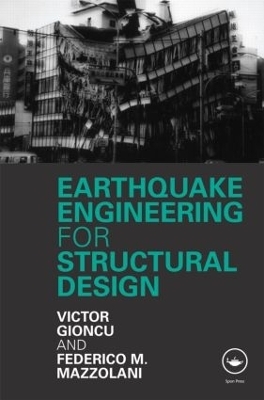
Earthquake Engineering for Structural Design
Seiten
2010
CRC Press (Verlag)
978-0-415-46533-5 (ISBN)
CRC Press (Verlag)
978-0-415-46533-5 (ISBN)
Developments in Earthquake Engineering have focused on the capacity and response of structures. They often overlook the importance of seismological knowledge to earthquake-proofing of design. This book focuses on the seismological aspects of design - analyzing various types of earthquake and how they affect structures differently.
Developments in Earthquake Engineering have focussed on the capacity and response of structures. They often overlook the importance of seismological knowledge to earthquake-proofing of design. It is not enough only to understand the anatomy of the structure, you must also appreciate the nature of the likely earthquake.
Seismic design, as detailed in this book, is the bringing together of Earthquake Engineering and Engineering Seismology. It focuses on the seismological aspects of design – analyzing various types of earthquake and how they affect structures differently. Understanding the distinction between these earthquake types and their different impacts on buildings can make the difference between whether a building stands or falls, or at least to how much it costs to repair.
Covering the basis and basics of the major international codes, this is the essential guide for professionals working on structures in earthquake zones around the world.
Developments in Earthquake Engineering have focussed on the capacity and response of structures. They often overlook the importance of seismological knowledge to earthquake-proofing of design. It is not enough only to understand the anatomy of the structure, you must also appreciate the nature of the likely earthquake.
Seismic design, as detailed in this book, is the bringing together of Earthquake Engineering and Engineering Seismology. It focuses on the seismological aspects of design – analyzing various types of earthquake and how they affect structures differently. Understanding the distinction between these earthquake types and their different impacts on buildings can make the difference between whether a building stands or falls, or at least to how much it costs to repair.
Covering the basis and basics of the major international codes, this is the essential guide for professionals working on structures in earthquake zones around the world.
Victor Gioncu is Professor for Structural Design at the "Politechnica" University of Timisoara. Federico M. Mazzolani is Professor of Structural Engineering at the University of Naples "Federico II", Italy.
1. Living with Earthquakes 2. Learning from Earthquakes 3. Engineering Seismology and Earthquake Engineering 4. Advances in Conception About Earthquakes 5. Tectonic Plates and Faults 6. Faults and Earthquakes 7. Earthquakes and Structures 8. New Design Philosophies 9. Progress and Challenges in Codifications
| Erscheint lt. Verlag | 4.8.2010 |
|---|---|
| Zusatzinfo | 450 Line drawings, black and white; 50 Halftones, black and white |
| Verlagsort | London |
| Sprache | englisch |
| Maße | 156 x 234 mm |
| Gewicht | 996 g |
| Themenwelt | Technik ► Bauwesen |
| Technik ► Umwelttechnik / Biotechnologie | |
| ISBN-10 | 0-415-46533-8 / 0415465338 |
| ISBN-13 | 978-0-415-46533-5 / 9780415465335 |
| Zustand | Neuware |
| Haben Sie eine Frage zum Produkt? |
Mehr entdecken
aus dem Bereich
aus dem Bereich
Kommentar zu VOB/C ATV DIN 18340, ATV DIN 18299
Buch | Softcover (2024)
DIN Media (Verlag)
69,00 €
Grundlagen und Vorgehensweisen
Buch | Softcover (2021)
Springer Fachmedien Wiesbaden GmbH (Verlag)
37,99 €
Buch | Softcover (2024)
Springer Vieweg (Verlag)
18,99 €


